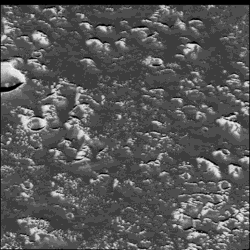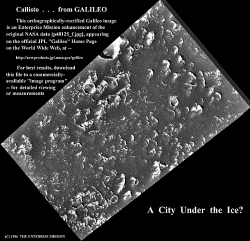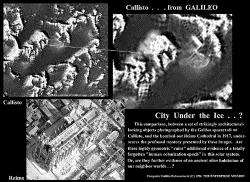Galileo's Most Marvelous Discovery ?
Once upon a time, a race of curious beings living on the third planet outward from the Sun decided to build an exploratory device -- a "technological messenger" -- and send it on a one-way journey to take up an orbit of the fifth... to report back what it found.
The journey of their messenger was long and perilous, being fraught with many dangers, breakdowns and "workarounds" totally unforeseen when it was originally being planned; in fact, the final journey lasted years longer than the masters of the messenger could have ever imagined -- actually taking the messenger inward toward the Sun, past the second planet, eventually sending it looping past the third world two separate times... before it could finally embark on its years'-long journey outward... to an eventual orbit of the fifth world--
Known to us as "Jupiter."
 The "technological messenger" being sent to Jupiter had a name:
the same as one of the third world's most revered historical figures --
an astronomer known as "Galileo." This astronomer's major claim
to historical significance was that, centuries before his namesake's journey,
when the original Galileo had aimed a much more primitive technological
device (called a "telescope") at the very distant fifth world
. . . he discovered that this outer planet was actually orbited by four
moon-sized objects--
The "technological messenger" being sent to Jupiter had a name:
the same as one of the third world's most revered historical figures --
an astronomer known as "Galileo." This astronomer's major claim
to historical significance was that, centuries before his namesake's journey,
when the original Galileo had aimed a much more primitive technological
device (called a "telescope") at the very distant fifth world
. . . he discovered that this outer planet was actually orbited by four
moon-sized objects--
Which created no small problem for the original "Galileo"... because for a long, long time... he was not believed.
It would not be until hundreds of years later that Galileo's profound astronomical discovery -- that "planets" can also possess "satellites," thereby proving that not all objects have to "go around" (orbit) the third world (also known as "Earth") -- would be commonly accepted by the social and religious institutions and authorities governing the Sun's third planet; this deceptively simple finding would ultimately reshape the view of almost every inhabitant of this third planet from the Sun... opening up the Cosmos to even more astounding possibilities to come...
And slowly, too slowly, the "moons of Jupiter" would become known to all upon the third world as they should have been known from the date of their discovery--
As "the Galilean moons."
Now, hundreds of years later, another "Galileo" has journeyed all the way to Jupiter to continue the work that its namesake started so many years before. And, sadly, history is about to strikingly repeat itself:
 For,
this Galileo too, even as you read this, is reporting back revolutionary
findings about Jupiter's "Galilean moons" -- ultimately, destined
once again to change the nature of our perceptions of the solar system...
and the Universe beyond; for like its namesake, these new findings are
also simply too astonishing to be believed... at least at first.
For,
this Galileo too, even as you read this, is reporting back revolutionary
findings about Jupiter's "Galilean moons" -- ultimately, destined
once again to change the nature of our perceptions of the solar system...
and the Universe beyond; for like its namesake, these new findings are
also simply too astonishing to be believed... at least at first.
For, this "Galileo" has electronically returned, and the Enterprise Mission has discovered... this time, on two of the four "Galilean moons"... the first testable evidence of intelligently-constructed artifacts present in the outer solar system... present on those moons.
This evidence -- highly detailed images of three-dimensional, geometric, intensely artificial-looking structures -- and the Enterprise Mission preliminary comparisons, analyses and computer enhancements of these objects -- is reported here.
This is only the beginning.
There will be further images, updated analyses, and reaction in the days to come.
Enjoy, examine... and stay tuned.
[Click on Images to View Full-Size]
 This
is an unenhanced, perspective Galileo image of Callisto -- code-named
"p48125_f.jpg" on the JPL "Galileo Website" (https://newproducts.jpl.nasa.gov/galileo).
It was taken a few weeks ago, during the third orbit spacecraft swingby
of the outermost Galilean moon, Callisto, at a distance of approximately
800 miles. The frame is about 7 miles from side to side and the smallest
features seen are about 200 feet across -- comparable to Viking's resolution
at Cydonia.
This
is an unenhanced, perspective Galileo image of Callisto -- code-named
"p48125_f.jpg" on the JPL "Galileo Website" (https://newproducts.jpl.nasa.gov/galileo).
It was taken a few weeks ago, during the third orbit spacecraft swingby
of the outermost Galilean moon, Callisto, at a distance of approximately
800 miles. The frame is about 7 miles from side to side and the smallest
features seen are about 200 feet across -- comparable to Viking's resolution
at Cydonia.
 This
is an Enterprise Mission "orthographically-rectified" version
of this same NASA frame. Note the sets of strikingly rectilinear (right-angle)
features clumped across the image. If you download
the high-resolution version (NOT the browser image seen here!), you
will see an even more astonishing array of inexplicable "architectural"
forms--
This
is an Enterprise Mission "orthographically-rectified" version
of this same NASA frame. Note the sets of strikingly rectilinear (right-angle)
features clumped across the image. If you download
the high-resolution version (NOT the browser image seen here!), you
will see an even more astonishing array of inexplicable "architectural"
forms--
 As
is evident in this third image comparison, prepared by the Enterprise
Mission specifically for this presentation.
As
is evident in this third image comparison, prepared by the Enterprise
Mission specifically for this presentation.
These regular geometries -- and eerie similarities to known architectural forms, but on a world where they simply DO NOT BELONG -- beg for official attention... and adequate scientific explanation by the NASA Galileo Project.
There are more images, discoveries, and analyses to come.
Stay tuned.